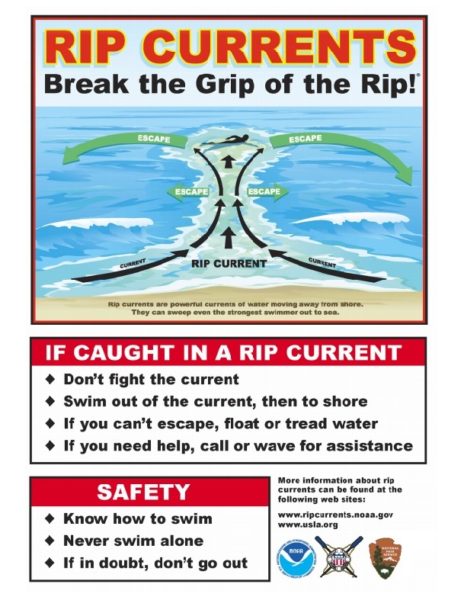Rip Current Safety Rules

As you head to the beach this spring and summer, here are some important tips to survive rips currents and surf conditions. Bathers can stay safe this summer by keeping in mind some simple rules:
Do not overestimate your swimming abilities. If the surf is up, and you are not experienced with large waves, stay out of the water. If you are not an experienced swimmer and cannot keep yourself afloat for extended periods, do not enter the water when the surf is running.
Learn to recognize dangerous ocean conditions and rip currents. As waves pile up onto the beach, the water forms rip currents as it heads back out to sea. You can usually identify these currents as rivers of white water flowing away from the beach. These currents are powerful and will pull even the strongest swimmers out to sea.
Stay calm, do not panic. Your chances of surviving a rip current or any swimming experience are drastically improved by staying calm and maintaining your ability to assess the situation.
Never fight the rip. If you find yourself being pulled out to sea, do not fight the current by trying to swim back to shore. Stay calm and go with the flow. Keep yourself afloat by treading water or swimming parallel to the beach. In a few minutes, the current will dissipate.
Duck under the waves. Breaking waves pack a pretty good punch when they hit a floating object. The secret is to duck under the waves. By submerging yourself only 2-3 feet under the water, you will avoid almost all of a wave’s impact and safely pop back up on the other side. You will only have to hold your breath a few seconds, and this simple maneuver—routinely used by surfers and experienced swimmers—can save your life.
The other side of the “Impact Zone.” Waves on any given beach usually break in an area known as the “Impact Zone.” This is not a friendly place for swimmers or someone caught in a rip current. Just on the other side of the zone, however, conditions are generally calm, the rip current fades, and a swimmer can easily float over the waves while keeping their head above water.
Catch your breath/call for help. After you have gone with the flow and have allowed the rip current to take you out past the “Impact Zone,” you can catch your breath and signal for help. It may seem like you are very far from the beach, but you are generally safe here as long as you can tread water and keep yourself afloat. At this point, you can swim parallel to the beach to a calmer area to wait for help to arrive.
Let the waves do the work. If no help is available and you need to get back to the beach on your own, swim with the waves back toward the beach. Take your time and remember to duck under the larger waves. Again, go with the flow, and soon, the waves will push you back toward the beach.
Category: STANDBY















